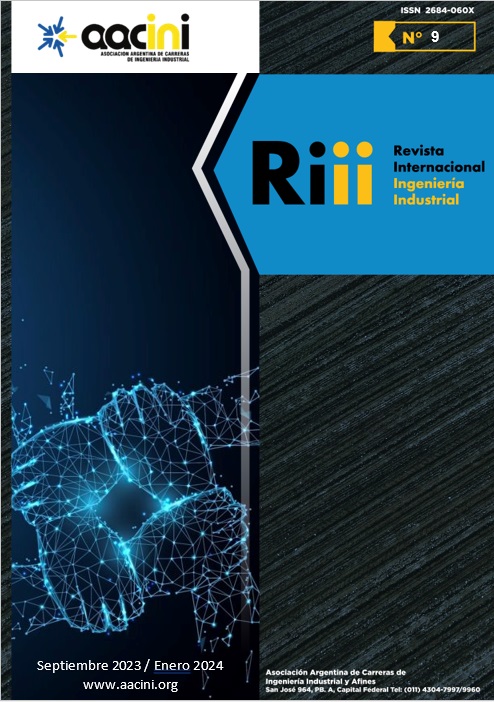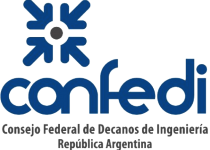Tecnologías inteligentes para el agregado de valor a los procesos productivos de una empresa alimenticia
Un caso de estudio
Resumen
El avance de la tecnología de los últimos años induce a las industrias a adaptar sus procesos a entornos cada vez más cambiantes y a la demanda de un mayor valor agregado en los productos y servicios por parte de sus clientes. Si bien muchas organizaciones logran un ritmo de crecimiento adecuado, otras necesitan hacer cambios considerables para alcanzarlo. El objetivo del presente trabajo consiste identificar puntos de mejora a los procesos productivos de una empresa alimenticia multinacional a través de la incorporación de tecnologías de la Industria 4.0. En base un diagnóstico tecnológico inicial, se aplica Soft System Methodology con el propósito de detectar en forma participativa las principales debilidades del proceso y diseñar un plan de acción para su abordaje. Con el fin de priorizar las acciones delineadas en el plan, se implementa el Proceso Analítico Jerárquico. Se obtiene como resultado un plan de incorporación tecnologías inteligentes que genera mejoras significativas en los procesos productivos de la empresa bajo estudio, alcanzando una reducción del 35,47% de las horas hombre y optimizando el flujo de información entre áreas. Se concluye que las mejoras propuestas permiten a la empresa afrontar un proceso de transformación tecnológica, mejorar la disponibilidad de información clave para la toma de decisiones y agregar valor a las operaciones en toda la cadena de suministro.
Descargas
Citas
Anderson, D., Sweeny, D., & Williams, T. (2004). Métodos cuantitativos para los negocios (10ma. edición). Editorial Thomson.
Barcia, K., & De Loor, C. (2007). Metodología para Mejorar un Proceso de Ensamble Aplicando el Mapeo de la Cadena de Valor (VSM). Revista Tecnológica ESPOL, 20(1), 31-38. http://www.rte.espol.edu.ec/index.php/tecnologica/article/view/159/103
Basco, A.; Beliz, G.; Coatz, D.; & Garnero, P. (2018). Industria 4.0: Fabricando el futuro. BID. http://dx.doi.org/10.18235/0001229.
Castillo, M., Gligo, N., & Rovira, S. (2017). La política industrial 4.0 en América Latina. CEPAL. https://repositorio.cepal.org/bitstream/handle/11362/43944/S1700602_es.pdf?sequence=1&isAllowed=y
Cavusgil, S., Knight, G. & Riesenberger, J. (2020). International business: The new realities. Pearson.
Checkland, P.; Holwell, S. (1998), Information, Systems and Information Systems making sense of the field. Editorial John Wiley and Sons.
Checkland, P., Poulter, J. (2020). Soft Systems Methodology. En: Reynolds, M., Holwell, S. (Eds.), Systems Approaches to Making Change: A Practical Guide. (pp. 201–253). Springer. https://doi.org/10.1007/978-1-4471-7472-1_5
Clemons, E. K. (2019). New patterns of power and profit: A strategist’s guide to competitive advantage in the age of digital transformation. Palgrave Macmillan.
Davis, G. F. (2016). What might replace the modern corporation? Uberi¬zation and the web page enterprise. Seattle University Law Review, 39(2), 501-516. https://webuser.bus.umich.edu/gfdavis/Papers/Davis_SULR_2016.pdf
del Val Román, J. L. (2016). Industria 4.0: la transformación digital de la industria. Facultad de Ingeniería de la Universidad de Deusto. http://coddii.org/wp-content/uploads/2016/10/Informe-CODDII-Industria-4.0.pdf.
Garza-Ríos, R., González-Sánchez, C., Pérez-Vergara, I., Martínez-Delgado, E., & Sanler-Cruz, M. (2012). Concepción de un procedimiento utilizando herramientas cuantitativas para mejorar el desempeño empresarial. Ingeniería Industrial, 33(3), 239-248. http://scielo.sld.cu/scielo.php?script=sci_arttext&pid=S1815-59362012000300004&lng=es&tlng=es
Gil Torrijos, M (2018). La selección de proveedores, elemento clave en la gestión de aprovisionamientos [Tesis de Maestría, Universidad de Oviedo]. Repositorio Institucional de la Universidad de Oviedo. http://hdl.handle.net/10651/47803
Gomes, L, & Zanazzi, J. (2009). La búsqueda de acuerdos en equipos de trabajo: el método decisión con reducción de la variabilidad (DRV). Pesquisa Operacional, 29(1), 195-221. https://www.scielo.br/j/pope/a/XBtNdgBphPXmWRwqH3bnQ3N/?format=pdf
González, M., Vidal, L., Tabone, L., & Morcela, A. (2022). Incorporación de tecnologías inteligentes para el agregado de valor en una empresa alimenticia marplatense. Memorias del XV Congreso Internacional de Ingeniería Industrial. Mar del Plata, Argentina.
Gonzalez-Urango, H. (2021). How the Analytic Hierarchy/Network Process Supports a More Responsible and Committed Research and Innovation. International Journal of the Analytic Hierarchy Process, 13(3), 553-558. https://doi.org/10.13033/ijahp.v13i3.949.
Joyanes Aguilar, L. (2017). Ciberseguridad: la colaboración público-privada en la era de la cuarta revolución industrial (Industria 4.0 versus ciberseguridad 4.0). Cuadernos de estrategia, 185, 19-64. https://dialnet.unirioja.es/descarga/articulo/6115620.pdf
Martínez Rodríguez (2007). Aplicación del proceso jerárquico de análisis en la selección de la localización de una PYME. Anuario Jurídico y Económico Escurialense, 40, 523-542. https://dialnet.unirioja.es/servlet/articulo?codigo=2267954.
Mingers, J. (2011). Soft OR comes of age – but not everywhere! Omega, 39(6), 729-741. https://doi.org/10.1016/j.omega.2011.01.005
Montoya, R., Mazo, A., & Noreña, G. (2015). Método AHP utilizado para mejorar la recepción en el centro de distribución de una empresa de alimentos. Ingenierías USBmed., 6 (2), 5-14. https://doi.org/10.21500/20275846.1726
Munier, N. (2011). Procedimiento fundamentado en la programación lineal para la selección de alternativas en proyectos de naturaleza compleja y con objetivos múltiples [Tesis de Doctorado, Universitat Politècnica de València]. https://doi.org/10.13140/RG.2.1.2204.3367.
Nantes, E. A. (2019). El método Analytic Hierarchy Process para la toma de decisiones. Repaso de la metodología y aplicaciones. Revista De La Escuela De Perfeccionamiento En Investigación Operativa, 27(46), 54-73. https://revistas.unc.edu.ar/index.php/epio/article/view/26474
Nash, M., & Poling S. (2008). Mapping the Total Value Stream (1ra edición). Taylor & Francis Group.
Rivera Chávez, A. (2008). IT Project Portfolio Selection using Analytic Hierarchy Process. Industrial Data, 11(2), 59-62. https://www.redalyc.org/articulo.oa?id=816/81619829008
Saaty (2008). Decision Making with the Analytic Hierarchy Process. International. Journal of Services Sciences,1(1), 83-98. https://doi.org/10.1504/IJSSCI.2008.017590.
Salas Bacalla, J., Leyva Caballero, M., & Calenzani Fiestas, A. (2014). Modelo del proceso jerárquico análitico para optimizar la localización de una planta industrial. Industrial Data, 17(2), 112-119. https://doi.org/10.15381/idata.v17i2.12056.
Schwab, K. (2016). The Fourth Industrial Revolution. Economía, XLI(81), 194-197. https://doi.org/10.18800/economia.201801.012
Serrano, S., Alonso, P., & Rivera, M. (2021). Proceso Analítico Jerárquico (AHP) como método multicriterio para la localización óptima de estaciones intermodales. Economía Sociedad y Territorio, 21(66), 315-358. https://doi.org/10.22136/est20211583.
Tabone, L., & Mortara, V. (2022). Modelo para la definición de los requisitos de un sistema de información en una organización de salud de Mar del Plata, Argentina. Ingeniería Industrial, 42(42), 159-181. https://doi.org/10.26439/ing.ind2022.n42.5705
Tabone, L, Mortara, V., & Zanfrillo, A. (2021) Agregado de valor en proceso productivo combinando Soft Systems Methodology y simulación. Ingeniería Industrial, 42 (1),1-15. https://rii.cujae.edu.cu/index.php/revistaind/article/view/1043/1007
Tapiero, S., Trujillo Barrios, D., & Guzmán, N. (2017). Aplicação de processo AHP analytic hierarchy para definir o melhor café da avaliação dos cafés especiais. Coffee Science, 12(3), 374-380. https://doi.org/10.25186/cs.v12i3.1301
Valqui Vidal, R. (2010). La investigación de operaciones: un campo multidisciplinario. Operational Research: A mulidisciplinary Field, 47-52. https://docplayer.es/77343715-La-investigacion-de-operaciones-un-campo-multidisciplinario
Xu, Z. & Liao, H. (2014). Intuitionistic Fuzzy Analytic Hierarchy Process. IEEE Transactions on Fuzzy Systems, 22(4), 749-761. https://doi.org/10.1109/TFUZZ.2013.2272585.
Zanazzi J. L., Cabrera, G. P., Castellini, A., & Salamon, A. G. (2014). Análisis de un problema de selección de grupos de trabajo mediante investigación operativa soft. En: J. L. Zanazzi, C. L. Alberto y C. E. Carignano (Eds.), Aplicación de multi-metodologías para la gestión y evaluación de sistemas sociales y tecnológicos. (tomo II, pp. 203-223). Asociación Cooperadora de la Facultad de Ciencias Económicas de la UNC. https://rdu.unc.edu.ar/handle/11086/1336?show=full
Zanfrillo, A.; Morcela, A.; Mortara, V; Tabone, L.; Carrizo, G.; Gadaleta, L.; Delmonte, P.; Massano, R. & Bounoure, J. (2020). Industria inteligente para el agregado de valor a la cadena de suministro regional. Jornadas INVESTIGAR UNMDP 2020, Mar del Plata, Argentina.


































































